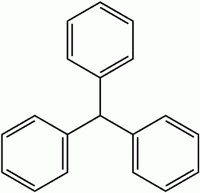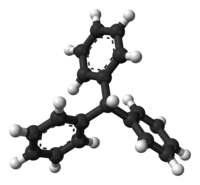Triphenylmethane
 |
|
 |
|
| Names | |
|---|---|
|
Preferred IUPAC name
1,1',1''-Methanetriyltribenzene
|
|
| Other names
Triphenylmethane
1,1',1"-Methylidynetrisbenzene |
|
| Identifiers | |
|
519-73-3 |
|
| 3D model (Jmol) | Interactive image |
| ChEBI |
CHEBI:76212 |
| ChemSpider |
10169 |
| ECHA InfoCard | 100.007.524 |
| EC Number | 208-275-0 |
| PubChem | 10614 |
|
|
|
|
| Properties | |
| C19H16 | |
| Molar mass | 244.33 g/mol |
| Appearance | Colorless solid |
| Density | 1.014 g/cm3 |
| Melting point | 92 to 94 °C (198 to 201 °F; 365 to 367 K) |
| Boiling point | 359 °C (678 °F; 632 K) |
| insoluble | |
| Solubility | soluble in dioxane and hexane |
| Acidity (pKa) | 33 |
| -165.6·10−6 cm3/mol | |
| Hazards | |
| Safety data sheet | External MSDS |
| R-phrases | R36 R37 R38 |
|
Except where otherwise noted, data are given for materials in their standard state (at 25 °C [77 °F], 100 kPa).
|
|
|
|
|
| Infobox references | |
Triphenylmethane, or triphenyl methane, is the hydrocarbon with the formula (C6H5)3CH. This colorless solid is soluble in nonpolar organic solvents and not in water. Triphenylmethane is the basic skeleton of many synthetic dyes called triarylmethane dyes, many of them are pH indicators, and some display fluorescence. A trityl group in organic chemistry is a triphenylmethyl group Ph3C, e.g. triphenylmethyl chloride (trityl chloride) and the triphenylmethyl radical (trityl radical).
Triphenylmethane was first synthesized in 1872 by the German chemist August Kekulé and his Belgian student Antoine Paul Nicolas Franchimont (1844–1919) by heating diphenylmercury (Hg(C6H5)2, Quecksilberdiphenyl) with benzal chloride (C6H5CHCl2, Benzylenchlorid).
Triphenylmethane can be synthesized by Friedel-Crafts reaction from benzene and chloroform with aluminium chloride catalyst:
Alternatively, benzene may react with carbon tetrachloride using the same catalyst to obtain the trityl chloride-aluminium chloride adduct, which is hydrolyzed with dilute acid:
Synthesis from benzylidene chloride, prepared from benzaldehyde and phosphorus pentachloride, is used as well.
...
Wikipedia
